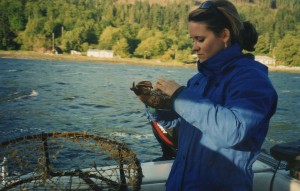Adjunct Professor, IRES
Visiting Scientist, North Pacific Marine Science Organization (PICES)
Home Research Publications Presentations
Email: cclarkeATeos.ubc.ca
I am a marine ecologist broadly interested in the interaction of human and natural systems. My research follows two major themes: ecosystem management and invasive species. I am currently a Visiting Scientist with the North Pacific Marine Science Organization (PICES) working on the impact of tsunami debris. My postdoctoral research focused on risk assessment and the cumulative impact of human activities in the marine realm. I also investigate the introduction and spread of invasive species; my dissertation research examined the role of recreational boating in carrying potentially invasive subtidal marine species.
Select Publications:
Clarke Murray, C., Agbayani, S., & Ban, N. C. 2015. Cumulative effects of planned industrial development and climate change on marine ecosystems. Global Ecology and Conservation, 4, 110-116.
Clarke Murray, C., Agbayani, S., Alidina, H. M., & Ban, N. C. 2015. Advancing marine cumulative effects mapping: An update in Canada’s Pacific waters. Marine Policy, 58, 71-77.
Clarke Murray, C., Mach, M.E., Goldman Martone, R. 2014. Cumulative effects in marine ecosystems: Scientific perspectives on its challenges and solutions. WWF-Canada and Center for Ocean Solutions Joint Report. 48pp. http://awsassets.wwf.ca/downloads/cumulativeeffects__updated_forwebupload_singlepages.pdf
Clarke Murray, C., Mach, M.E., Goldman Martone, R. and O, M. In Press. Pilot ecosystem risk assessment to assess cumulative risk to species in the Pacific North Coast Integrated Management Area (PNCIMA). Canadian Science Advisory Secretariat Research Document 2015/nnn
Clarke Murray, C., Gartner, H., Gregr, E. J., Chan, K., Pakhomov, E., & Therriault, T. W. 2014. Spatial distribution of marine invasive species: environmental, demographic and vector drivers. Diversity and distributions, 20(7), 824-836.
Clarke Murray, C. TW Therriault. and EA Pakhomov. 2013. What Lies Beneath? An Evaluation of Rapid Assessment Tools for Management of Hull Fouling. Environmental Management, 1-11
Clarke Murray, C, TW Therriault and PT Martone. 2012. Adapted for invasion? Comparing attachment, drag and dislodgment of native and nonindigenous hull fouling species. Biological Invasions DOI: 10.1007/s10530-012-0178-0
Clarke Murray, C, EA Pakhomov and TW Therriault. 2011. Recreational boating: a large unregulated vector transporting marine invasive species. Diversity and Distributions. 17(6):1161-1172 DOI: 10.1111/j.1472-4642.2011.00798.x
Francisco Sylvester, Odion Kalaci, Brian Leung, Anaı¨s Lacoursiere-Roussel, Cathryn Clarke Murray, Francis M. Choi, Monica A. Bravo, Thomas W. Therriault and Hugh J. MacIsaac. 2011. Hull fouling as an invasion vector: can simple models explain a complex problem? Journal of Applied Ecology. Early online. DOI. 10.1111/j.1365-2664.2011.01957.x
Melissa A. Frey, Heidi N. Gartner, Cathryn Clarke Murray and Thomas W. Therriault. 2009. Aquatic Invasions. First confirmed records of the non-native amphipod Caprella mutica (Schurin 1935) along the coast of British Columbia, Canada, and the potential for secondary spread via hull fouling. Volume 4(3): 495-499

